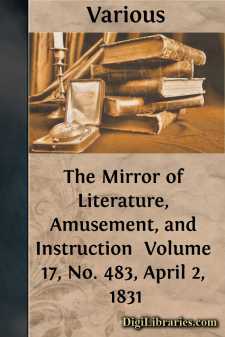Categories
- Antiques & Collectibles 13
- Architecture 36
- Art 48
- Bibles 22
- Biography & Autobiography 813
- Body, Mind & Spirit 142
- Business & Economics 28
- Children's Books 17
- Children's Fiction 14
- Computers 4
- Cooking 94
- Crafts & Hobbies 4
- Drama 346
- Education 46
- Family & Relationships 57
- Fiction 11829
- Games 19
- Gardening 17
- Health & Fitness 34
- History 1377
- House & Home 1
- Humor 147
- Juvenile Fiction 1873
- Juvenile Nonfiction 202
- Language Arts & Disciplines 88
- Law 16
- Literary Collections 686
- Literary Criticism 179
- Mathematics 13
- Medical 41
- Music 40
- Nature 179
- Non-Classifiable 1768
- Performing Arts 7
- Periodicals 1453
- Philosophy 64
- Photography 2
- Poetry 896
- Political Science 203
- Psychology 42
- Reference 154
- Religion 513
- Science 126
- Self-Help 84
- Social Science 81
- Sports & Recreation 34
- Study Aids 3
- Technology & Engineering 59
- Transportation 23
- Travel 463
- True Crime 29
The Mirror of Literature, Amusement, and Instruction Volume 17, No. 483, April 2, 1831
by: Various
Categories:
Description:
Excerpt
GROTTO AT ASCOT PLACE.
Here is a picturesque contrivance of Art to embellish Nature. We have seen many such labours, but none with more satisfaction than the Grotto at Ascot Place.
This estate is in the county of Surrey, five miles south-east from Windsor, on the side of Ascot Heath, near Winkfield. The residence was erected by Andrew Lindergreen, Esq.; at whose death it was sold to Daniel Agace, Esq., who has evinced considerable taste in the arrangement of the grounds. The house is of brick, with wings. On the adjoining lawn, a circular Corinthian temple produces a very pleasing effect. The gem of the estate is, however, the above Grotto, which is situate at the end of a canal running through the grounds. Upon this labour of leisure much expense and good taste have been bestowed. It consists of four rooms, but one only, for the refreshing pastime of tea drinking, appears to be completed. It is almost entirely covered with a white spar, intermixed with curious and unique specimens of polished pebbles and petrifactions. The ceiling is ornamented with pendants of the same material; and the whole, when under the influence of a strong sun, has an almost magical effect. These and other decorations of the same grounds were executed by a person named Turnbull, who was employed here for several years by Mr. Agace. Our View is copied from one of a series of engravings by Mr. Hakewill, the ingenious architect; these illustrations being supplementary to that gentleman’s quarto History of Windsor.
We request the reader to enjoy with us the delightful repose—the cool and calm retreat—of the Engraving. Be he never so indifferent a lover of Nature, he must admire its picturesque beauty; or be he never so enthusiastic, he must regard with pleasure the ingenuity of the artist. To an amateur, the pursuit of decorating grounds is one of the most interesting and intellectual amusements of retirement. We have worshipped from dewy morn till dusky eve in rustic temples and “cool grots,” and have sometimes aided in their construction. The roots, limbs, and trunks of trees, and straw or reeds, are all the materials required to build these hallowed and hallowing shrines. We call them hallowing, because they are either built, or directed to be built, in adoration of the beauties of Nature; who, in turn, mantles them with endless varieties of lichens and mosses. In the Rookery adjoining John Evelyn’s “Wotton” were many such temples dedicated to sylvan deities: one of them, to Pan, consists of a pediment supported by four rough trunks of trees, the walls being of moss and laths, and enclosed with tortuous limbs. Beneath the pediment is the following apposite line from Virgil:
Pan curat oves oviumque magistros.
Pan, guardian of the sheep and shepherds too.
Yet the building is not merely ornamental, for the back serves as a cow-house!
Pope’s love of grotto-building has made it a poetical amusement. Who does not remember his grotto at Twickenham—
The EGERIAN GROT,
Where, nobly pensive, ST....












